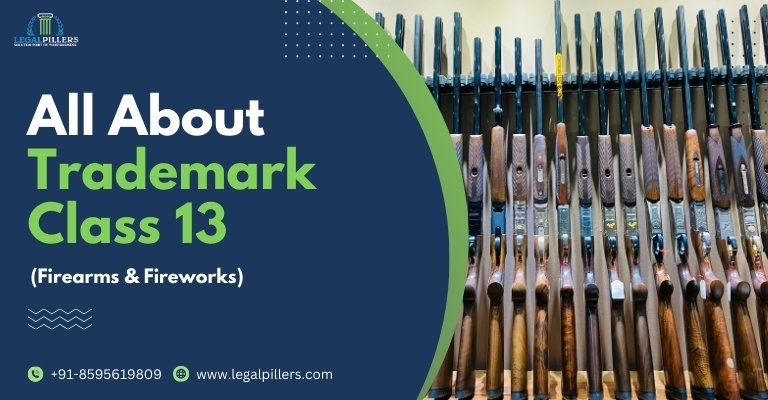
Table of Contents
All About Trademark Class 13
Trademark Class 13 encompasses a broad category of goods related to firearms, ammunition, and explosives. This class includes items such as firearms, firearm accessories, ammunition, explosives, fireworks, and certain pyrotechnic products. Businesses operating in this class typically manufacture, distribute, or sell these products and seek trademark protection to establish brand recognition and protect their unique identifiers in a specialized and regulated industry. Trademark registration in Class 13 helps prevent confusion among consumers and ensures that the origin of these potentially dangerous products is clear and traceable to specific manufacturers or suppliers.
Important goods included in Trademark Class 13
Trademark Class 13 mainly includes firearms and pyrotechnic products, including ammunition & projectiles, explosives, and fireworks. The goods included in this class are as follows:
- Rescue flares
- Explosive or pyrotechnic
- Flare pistols
- Sprays for personal defence purposes
- Explosive fog signals
- Signal rocket flares
- Air pistols being weapons
- Bandoliers for weapons
- Sporting firearms
- Hunting firearms
Goods does not included in Trademark Class 13
- Grease for weapons (included in Class 4)
- Blades being weapons (included in Class 8)
- Side arms, other than firearms (included in Class 8)
- Non-explosive fog signals (included in Class 9)
- Rescue laser signalling flares (included in Class 9)
- Telescopic sights for firearms (included in Class 9)
- Flaming torches (included in Class 11)
- Christmas crackers (included in Class 28)
- Percussion caps being toys (included in Class 28)
- Toy air pistols (included in Class 28)
- Matches (included in Class 34)
It is essential to consult with a trademark attorney or use official classification guidelines when seeking trademark protection to ensure your goods or services are correctly classified under the appropriate class.
To prevent any market misunderstanding in Trademark Class 13, trademarks are typically distinctive and distinct. Additionally, businesses must make sure that their trademarks are neither generic nor descriptive since these will not be protected under this class.
List of popular examples of Trademark Class 13
- Peacock: Peacock brand standard fireworks and explosives
- Ajanta Fireworks: Fireworks
- Solar: Solar Industries India Ltd.: Explosives and Detonators
- GOCL: GOCL Corporation Ltd.: Manufacturing of detonators, explosives, etc.
- Maxamcorp: Firearms, ammunition, projectiles, explosives, etc.
List of goods classified under Trademark Class 13
A
- Acetyl-nitrocellulose
- Air pistols [weapons]
- Ammonium nitrate explosives
- Ammunition
- Ammunition for firearms
- Artillery guns [cannons]
B
- Ballistic weapons or ballistic missiles
- Belts adapted for ammunition
- Bengal lights
- Breeches of firearms
C
- Cannons
- Cartridge cases
- Cartridge loading apparatus
- Cartridge pouches
- Cartridges
- Cleaning brushes for firearms
D
- Detonating plugs
- Detonating fuses for explosives/ firing lanyards for explosives
- Detonating caps other than toys/ percussion caps other than toys
- Detonators
- Dynamite
E
- Explosive cartridges
- Explosive powders
- Explosives
F
- Filling cartridge belts apparatus
- Firearm ammunition belts, automatic
- Firearms
- Firecrackers
- Fireworks
- Firing platforms
- Flare pistols
- Fog signals, explosive
- Fuses for explosives, for use in mines
- Fuses for explosives
G
- Gun carriages [artillery]
- Guncotton or pyroxylin
- Gunpowder
- Guns [weapons]
- Gunstocks
H
- Hammers for guns and rifles/ hammers for guns/ hammers for rifles
- Hand grenades
- Harpoon guns [weapons]
- Hunting firearms or sporting firearms
L
- Lead shot for hunting
M
- Mines [explosives]
- Mortars [firearms]
- Motorized weapons
N
- Noise-suppressors for guns
P
- Pistols [arms]
- Powder horns
- Primings [fuses]
- Projectiles [weapons]
- Pyrophoric substances
- Pyrotechnic products
R
- Rescue flares, explosive or pyrotechnic
- Revolvers
- Rifle barrels or gun barrels
- Rifle cases or gun cases
- Rifles and carbines
- Rocket launchers
- Rockets [projectiles]
S
- Shells [projectiles]
- Shoulder straps for weapons or bandoliers for weapons
- Side arms [firearms]
- Sighting mirrors for guns and rifles/ sighting mirrors for guns/ sighting mirrors for rifles
- Sights, other than telescopic sights, for firearms
- Sights, other than telescopic sights, for artillery
- Signal rocket flares
- Sprays for personal defence purposes/ sprays for personal defence purposes
T
- Tanks [weapons]
- Tear-gas weapons
- Torpedoes
- Trigger guards for guns and rifles or trigger guards for rifles
- Trunnions for heavy weapons
Conclusion
Trademark Class 13 is crucial for businesses operating in the firearms, ammunition, and explosives industry. This class covers a wide range of products, from firearms and ammunition to fireworks and pyrotechnics, helping companies establish their brand identity, gain consumer trust, and protect their unique identifiers in a highly regulated and specialized field. By registering trademarks in Class 13, businesses ensure clarity in product origin, reduce the risk of confusion among consumers, and maintain a competitive edge in a challenging market where safety and brand recognition are paramount.
At LegalPillers, we are here to help you to reduce the complications of classification & registration of the trademark and ensure that your band has been safeguarded within this trademark class.
Frequently Asked Questions (FAQs) about Trademark Class 13
-
What is Trademark Class 13?
Trademark Class 13 pertains to firearms, ammunition, explosives, fireworks, and certain pyrotechnic products.
-
Why is Class 13 important?
Class 13 is vital for businesses in this industry to protect their brand identity and distinguish their products from competitors.
-
What are some examples of goods in Class 13?
Examples include handguns, rifles, ammunition, fireworks, and explosives.
-
Can I trademark my gun brand in Class 13?
Yes, you can trademark the brand associated with firearms and related products within Class 13.
-
Do firearm accessories belong to Class 13?
Not necessarily. Accessories like holsters or scopes may belong to other classes, such as Class 18 or Class 28.
-
What about safety equipment like bulletproof vests?
Safety equipment is usually classified under different classes, like Class 9 (for protective gear).
-
Are all explosives covered in Class 13?
No, industrial explosives may belong to Class 1 (for chemicals).
-
Can I trademark fireworks under Class 13?
Yes, fireworks are a common product within this class.
-
What happens if I misclassify my trademark?
Misclassification may lead to trademark registration issues or infringement problems, so it is crucial to classify correctly.
-
How do I determine if my goods belong to Class 13?
Consult official classification guidelines or seek legal advice to ensure correct classification.
-
Can I register a trademark for non-lethal ammunition in Class 13?
Non-lethal ammunition may belong to other classes, such as Class 28 or Class 9.
-
Are airsoft guns classified under Class 13?
Airsoft guns are often classified under Class 28 (for sporting goods) or Class 13, depending on their characteristics.
-
What about historic firearms or antique guns?
These may fall under Class 13 if they are actively bought, sold, or traded as firearms.
-
Is gunpowder considered Class 13 goods?
Gunpowder is usually classified under Class 1 (for chemicals).
-
What is the purpose of classifying trademarks?
Classification helps organize trademarks, making it easier to search and register them.
-
Can I register a trademark in multiple classes?
Yes, you can register a trademark in multiple classes if your business offers goods or services across different categories.
-
How long does a Class 13 trademark registration last?
Typically, trademark registrations last 10 years but can be renewed indefinitely.
-
What is the difference between a trademark and a patent for firearms?
A trademark protects your brand identity, while a patent protects a specific invention or design of a firearm.
-
Do I need a lawyer to register a trademark in Class 13?
While it is not mandatory, consulting with a trademark attorney can help ensure a smooth registration process.
-
Can I license my Class 13 trademark to others?
Yes, trademark owners can license their trademarks to others, allowing them to use the mark under specific conditions and terms.



Leave a Reply